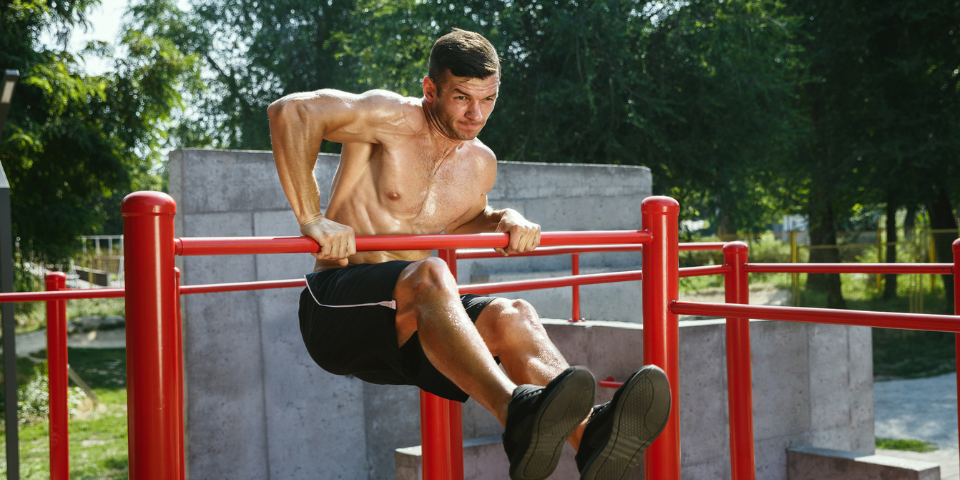[ad_1]
Unless you’re already a trained gymnast, the barbell curl is one of the hardest bodyweight movements you can try. In addition to core and upper body strength, muscle growth requires excellent mobility, body awareness, coordination, and timing.
If you decide to add muscle to your gym routine, know that there are right and wrong ways to develop this skill.
- Wrong method: Swinging and slamming your body into the bar repeatedly to the point of fatigue, frustration, and risk of injury.
- The right way: Muscle growth.
Pull-ups are a series of progressively more difficult movements that gradually develop your lifting technique while building strength. Each stage of the progression includes benchmarks that indicate readiness to move on to the next exercise in the progression.
The final step is, of course, a confident, flawlessly performed muscle tightening.
6-Step by Step Tiger Muscle Increase
Dr. A.S. John Gallucci, Jr., MS, ATC, PT, DPT, Executive Director I physical therapyexplained that muscle tightening is actually a series of small movements linked together.
- Kip swing
- Raise your knees
- Leg lift
- Pull the chest up
- Tighten the triceps
You must be comfortable repeating each of these movements to tone the muscles. This is where muscle growth comes in.
Developed by Gallucci and Jeff Waters, US registered boxing trainer and boxing owner. Watters performanceThe following muscle building process begins at the initial level. Depending on your gymnastics experience and current strength level, you may skip ahead.
Step 1: Raise your knees/legs
- Grab a dumbbell with a handle slightly wider than shoulder width.
- Hang your arms straight (a position known as a dead hang) and your legs straight and together.
- Bend your knees to 90 degrees and bring them to hip level. Hold for one second and then return to the starting position.
- Once you are able to do three sets of 10 reps, repeat the same movement with your legs straight so that your body forms an L shape. After three sets of 10 straight leg lifts, move on to the next step.
Advice: “Make sure you’re not using your energy to lift your leg, but that you’re doing all the work from your hip flexors and core,” says Gallucci.
Step 2: Help pull the chest up

- Loop one end of a large resistance band around the pull-up bar. Grab a handle that’s slightly wider than shoulder-width apart and place one foot on the other end of the resistance band.
- Hang at arm’s length with legs straight, core and glutes engaged.
- Without swinging or kicking (using momentum to lift yourself up), pull your chest up toward the bar, contracting your hamstrings and pinching your shoulder blades together.
- Pause, then return yourself to a dead hang.
Advice: “Start with a thicker band,” says Watters. “If you can do 10 full pull-ups, use a thin band. Over time, continue working your way down until you’ve done 10 tight pulls with the thinnest band. Then move on.”
Step 3: Pull tight from chest to bar

- Grab a pull-up bar with a handle that’s slightly more than shoulder-width apart.
- Straighten your arms and cross your ankles behind you.
- Without swinging or kicking, squeeze your shoulder blades and tighten your core, glutes, and hamstrings as you pull your chest toward the bar.
- Pause, then return yourself to a dead hang.
- Once you can complete three sets of 10 repetitions, continue. But while you’re working on new skills, keep doing chest pulls.
Advice: “At this stage, it’s important to work on the ‘push’ function, which is used to tighten the muscles,” says Watters.
He suggests incorporating push-ups into your workout plan, including push-ups, where you lower yourself down and lift your arms briefly before pushing into the plank to remove any momentum from the movement.
“Come halfway up from the floor position, then return to the ground. This is the hardest part of the push, so we emphasize it,” he said.
Step 4: Tighten the triceps
- Grasp the handles of the diving station and rise to a jumping or starting position: feet off the floor, arms straight, ankles crossed. (To make the movement easier, you can loop a large resistance band over the handle and place it on your knees.)
- Keeping your arms straight and elbows tucked (not flared), lower your body until your elbows form a 90-degree angle and lean your torso forward.
- Reverse the movement and return to the starting position. Once you can complete three sets of 10 repetitions, continue.
Step 5: Kip swing
- Grab a dumbbell with a handle slightly wider than shoulder width.
- Hang your arms straight and your legs together.
- Get into a hollow body position: arch your back and engage your core and core to tilt your pelvis back.
- Use your shoulders to stretch your chest forward, arch your back, and roll your legs behind you.
- Using your shoulders, core, and core, swing back into a hollow body position and begin pulling up as you would for a barbell pull from your chest.
- Once your chest is at bar level, complete three sets of 10 kip swings and fully contract your muscles.
Advice: Make sure you’re using your shoulders, not your hips, to create the swing.
Step 6: Tighten the muscles

- Hold the pull-up bar with a handle slightly wider than shoulder width.
- Hang with your arms straight and your core and glutes engaged.
- Start the kip swing: starting from a hollow position, use your shoulders to extend your chest forward and arch your back. Then use your shoulders, core, and core to rotate into a hollow body position. (Once you’re behind the bar, lean back and pull the bar down to get as high as you can.)
- Squeeze your shoulder blades and pull your hips toward the bar. As soon as your abs touch the bar, rotate your wrists forward, bend forward and straighten your elbows so your torso is over the bar.
- Hold, then lower to a dead hang position.
[ad_2]
Source link






